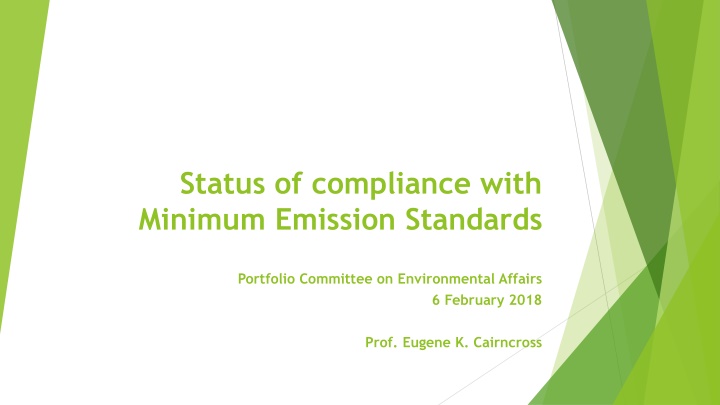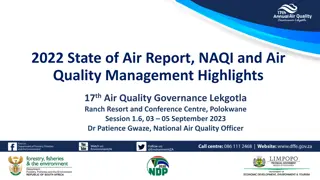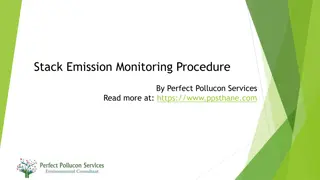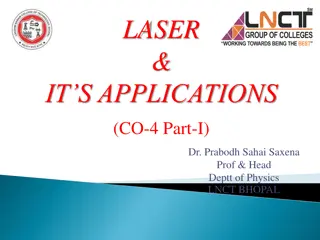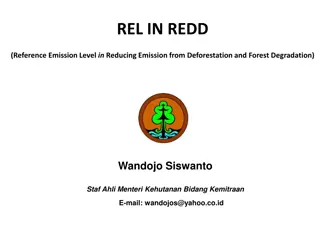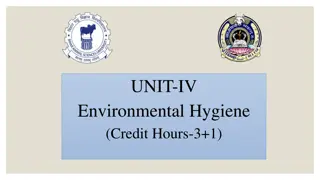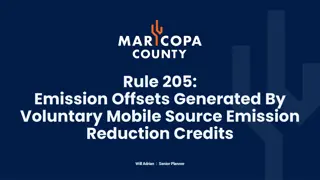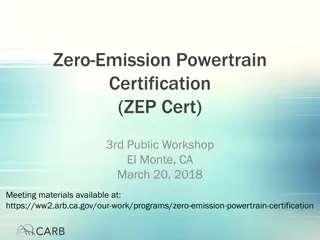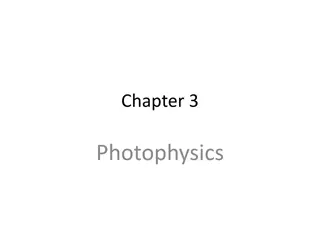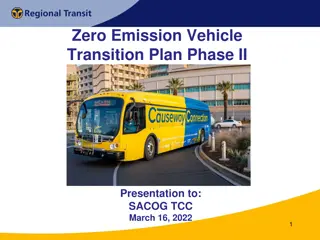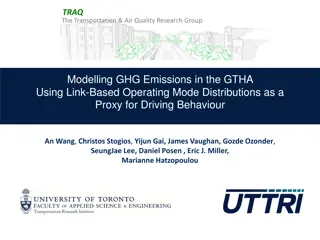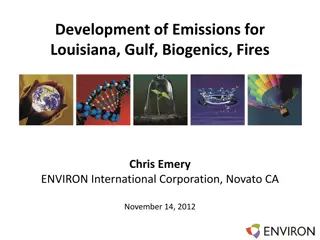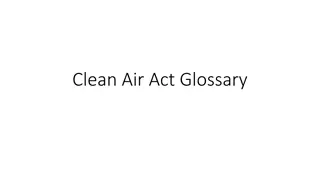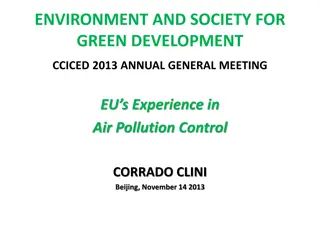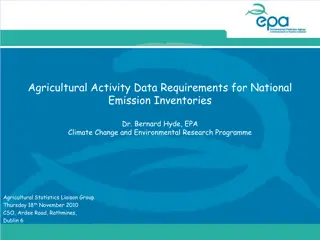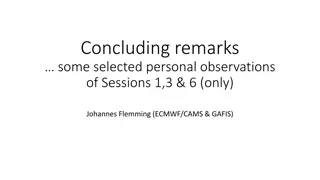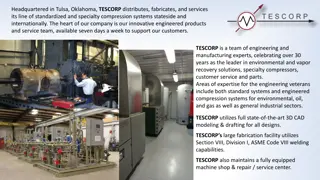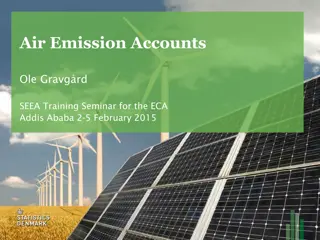Addressing Air Quality Challenges: Compliance with Emission Standards
Air quality in priority areas and neighboring regions remains poor due to emissions from Eskom's coal power stations. This report discusses the comparison of emission standards, SO2 abatement options, and pathways to achieve compliance. It highlights the leniency of South Africa's daily SO2 standard and provides an overview of pollution sources.
Uploaded on Sep 11, 2024 | 2 Views
Download Presentation

Please find below an Image/Link to download the presentation.
The content on the website is provided AS IS for your information and personal use only. It may not be sold, licensed, or shared on other websites without obtaining consent from the author.If you encounter any issues during the download, it is possible that the publisher has removed the file from their server.
You are allowed to download the files provided on this website for personal or commercial use, subject to the condition that they are used lawfully. All files are the property of their respective owners.
The content on the website is provided AS IS for your information and personal use only. It may not be sold, licensed, or shared on other websites without obtaining consent from the author.
E N D
Presentation Transcript
Status of compliance with Minimum Emission Standards Portfolio Committee on Environmental Affairs 6 February 2018 Prof. Eugene K. Cairncross
Air quality in the Priority Areas remains poor and unhealthy All Eskom s coal power stations operate in the three priority areas, and are major contributors to air pollutant emissions in these areas Comparison of the DEA s MES with other countries Focusing on Eskom s SO2 emissions; aggregate emissions, and emissions intensities of each plant SO2 abatement options, effectiveness and costs Possible pathways to achieving compliance and reducing impacts
Air quality in the Priority Areas, and adjacent areas, remains poor and unhealthy
Air quality in the Priority Areas remains poor and unhealthy SA NAAQS WHO guideline
Air quality in the Priority Areas remains poor and unhealthy SA NAAQS WHO guideline
Air quality in the Priority Areas remains poor and unhealthy SA NAAQS WHO guideline
Air quality in the Priority Areas remains poor and unhealthy SA NAAQS WHO guideline
The SA daily SO2 standard is extremely lenient: 2016 to 2017 data (May 2017 MSRG report) SA NAAQS WHO guideline
Location of Eskoms 15 coal power stations 14. Medup 15. Kusile
HPA: Pollution sources Data source: HPA AQMP
VTPA: Pollution sources Data source: VTPA AQMP: Mid-term review
The MES: the key to achieving substantial improvements in air quality It should be common cause that pollutant emissions are the root cause of poor air quality, although factors such as meteorology and seasons affect short-term variations in concentration. Reminder: Ambient PM2.5 is the result not only of the direct emissions of PM2.5 from various sources, but also the result of secondary PM2.5 formation. That is, the conversion of the precursors SO2 and NOx to PM2.5 through chemical and physical processes in the atmosphere. 40 to 60% of ambient PM2.5 is the result of secondary PM2.5 formation It is not possible to reduce PM2.5 to the required levels without reducing the emission of SO2 and NOx (and PM) at the same time It should be obvious: without significantly reducing pollutant emissions, a significant reduction in ambient concentrations cannot be expected.
SAs MES are extremely lax compared with international practice! Existing Plant ratios: SA/ country SO2 PM SA/ China SA/ Germany SA/ India SA/ Indonesia SA/ Thailand SA/ EU IED New Plant ratios: SA/ country 17.5 17.5 5.8 4.7 1.7 17.5 3.3 5.0 1.0 0.7 0.6 5.0 SO2 PM SA/ China SA/ Germany SA/ India SA/ Indonesia SA/ Thailand SA/ EU IED 14.3 3.3 5.0 0.7 1.0 3.3 5.0 5.0 1.7 0.5 0.6 5.0 Ref.: http://www.iea-coal.org.uk/documents/83882/9684/Emission-standards-and- control-of-PM2.5-from-coal-fired-power-plant,-CCC/267
Eskoms SO2 emissions Total SO2 emissions: 1.76 million tons; power generated: 200 893 GWh (2016/17)(Eskom data) Average SO2 emissions intensity is about 8.8 tons of SO2 per GWh generated; based on limited data, the range 6.0 to 11.4 tons of SO2 per GWh generated SO2 emissions from all of Eskom s coal plants are uncontrolled. There are no emission control systems in place Emissions are essentially a function of coal sulphur content, coal quality, and energy efficiency Based on limited data available, Matimba SO2 emissions are only marginally compliant or non-compliant with the existing plant standard of 3500 mg/Nm3 The most emissions-intensive plants are Matimba, Camden, Hendrina, Tutuka To meet the new plant MES, SO2 emission reductions of 80% to 90% on all Eskom coal stations required
Options for controlling SO2 emissions Reducing sulphur levels in coal, and blending to reduce day-to-day variability in sulphur content Direct injection of a dry sorbent (limestone) into the furnace, such as suggested by the World Bank (capable of about a 50% SO2 reduction) Wet, semi-dry or dry Flue Gas Desulphurisation (capable of up to 98% SO2 reduction) How to obtain credible and objective costs estimates, given the history of large cost and time over-runs on the Medupi and Kusile projects? Rigorous competitive tender? An objective techno-economic study?
Possible pathways to achieve compliance and aggregate SO2 emission reductions Accelerate the shut-down and decommissioning of the oldest plants (Grootvlei, Komati and Hendrina)(Kriel and Camden are also candidates) that are already underutilised, and will become increasingly redundant as the most recent rounds and future rounds of the REIPPP come on-stream, within the next two to four years. This clearly requires a transparent and properly negotiated process to mitigate the social and labour impacts of the decommissioning of these plants. Evaluate and expedite the installation of DSI on both Medupi and Matimba; expedite the installation of FGD on both Medupi and Matimba. Develop a plan to bring the rest of Eskom s coal plants into compliance with all 2020 MES by 2025, or to decommission them on an accelerated basis, based on maintaining security of power supply
